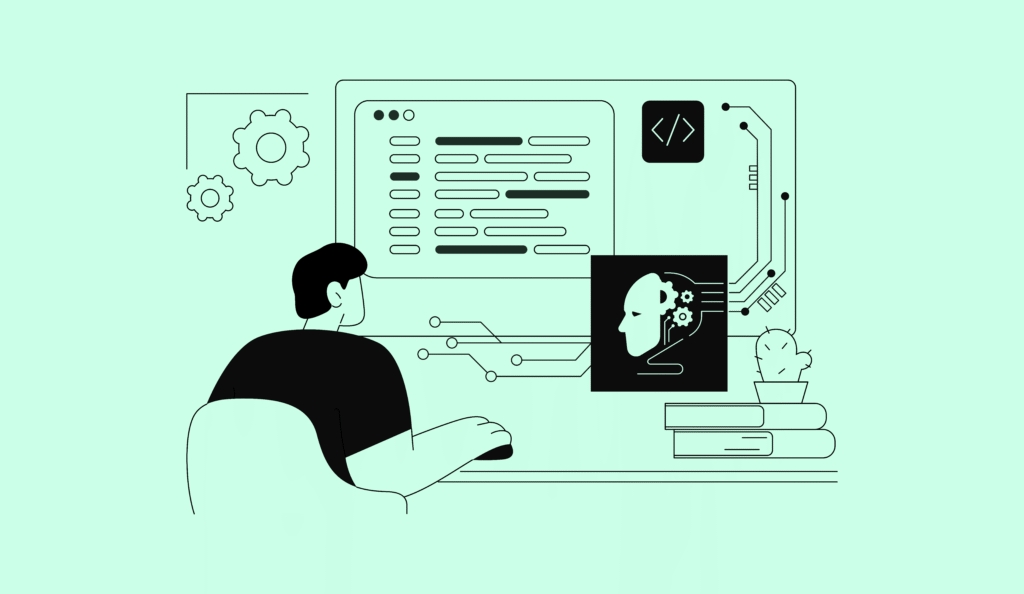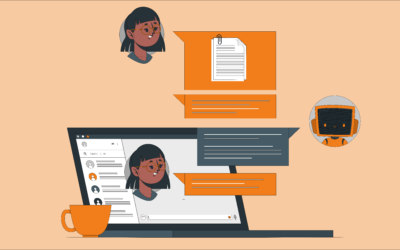Table of Content
Traditional SaaS platforms have long been built around a three‑layer architecture: a structured data layer (typically a relational database), a business‑logic layer (hard‑coded rules and workflows), and a user‑interface layer (web forms, dashboards, and APIs).
At their core, these applications perform operations on underlying data, enforcing validation and orchestrating routine processes in response to user actions. Customers pay for access to these UIs on a per‑seat basis, and developers spend the bulk of their time crafting front‑end interfaces, embedding business rules in code, and integrating disparate systems to deliver a coherent workflow.
Today, that model is being reimagined with the rise of AI agents. Rather than routing every interaction through a fixed UI and hard‑coded logic, next‑generation platforms incorporate AI-powered components into the orchestration process. These agents ingest natural‑language commands or higher‑level prompts, and dynamically generate code or API calls needed to manipulate data. They increasingly carry out multi‑step workflows across multiple systems, although their autonomy and reliability for highly complex, open-ended tasks are still evolving and often require orchestration frameworks and oversight.
The interface layer—once a collection of custom screens—is increasingly being augmented or, in some cases, supplemented by conversational or programmatic prompts, while some aspects of business logic are expressed through structured prompts and enhanced by techniques that retrieve relevant external information to guide AI responses. Behind the scenes, the database remains the single source of truth, but agents typically interact with it through APIs or orchestrators, rather than executing operations directly.
This shift has profound implications for both vendors and buyers. SaaS companies must re-architect their offerings to embed AI agents and agent frameworks, migrating from seat‑based subscription models toward outcome‑based pricing that charges for completed workflows or value delivered, though this pricing model is still emerging and gaining traction.
Vertical specialists will leverage industry‑tuned agents to automate niche processes, while horizontal platforms compete to provide the broadest toolkit of reusable “tools” and connectors that agents can invoke. Enterprises, in turn, gain the ability to automate complex tasks—such as dynamic campaign management, real‑time financial analysis, or cross‑system data consolidation—by simply telling an agent what they need rather than building custom interfaces or integrations.
For developers, the role shifts from crafting UI components and wiring business logic into building and securing the underlying APIs, designing robust data schemas, and developing “tool libraries” that agents call upon. Developer productivity is further accelerated by AI‑powered coding assistants, which can generate boilerplate, suggest optimizations, and even write data‑processing scripts on demand.
As a result, in‑house teams can prototype, iterate, and deploy new capabilities at unprecedented speed, focusing on governance, data quality, and model fine‑tuning rather than manual interface design.
In essence, we are witnessing the transformation of enterprise software from monolithic, screen‑driven applications into agent‑centric ecosystems. The database persists as the bedrock of all operations, but the layers that interpret, present, and act upon that data migrate into a flexible, AI‑driven tier.
Over time, traditional SaaS UIs may coexist with—rather than be entirely replaced by—general‑purpose agents that adapt to any domain or system, supporting a new era in which software more fluidly responds to intent and automates outcomes.
In this article, we will explore how AI agents are transforming software development, and outline strategies for riding this new wave of enterprise transformation.
AI is helping SaaS providers deliver smarter, more adaptive solutions that align with evolving enterprise needs.
AI SaaS
SaaS is undergoing a significant evolution by integrating artificial intelligence (AI) into its platforms. SaaS companies are expanding their layers and increasing their products’ functionalities to adapt to current technological changes, preparing their platforms to automate or augment complex tasks that were traditionally labor intensive.
With the incorporation of AI agents, clients can address more sophisticated tasks and automate many processes—reducing labor costs across marketing, sales, customer service, operations, and finance.
By embedding these AI capabilities, SaaS aims to help clients while increasing revenues through new business opportunities. This is especially true for vertical SaaS—specialized software targeting industry niches—where deep domain expertise enhances value. Leveraging their broad distribution and established client base, SaaS providers are evolving with new offerings so that enterprises can continue using their familiar platforms with AI capabilities to address general customer pain points without the immediate need to build a first‑AI solution.
For medium enterprises, this creates an ideal scenario: they can keep focusing on their core business rather than get into software development, stay in their comfort zone, and justify a higher price for solutions that reduce labor costs through these value propositions.
To deliver distinct advantages that standalone AI agents alone cannot provide—such as industry‑specific expertise, custom integrations, and specialized capabilities tailored to complex workflows—SaaS must carefully integrate AI into their systems. That is one of the primary arguments used by many SaaS vendors today.
Although such AI‑augmented platforms offer proven integration and industry‑focused features, it’s not possible to cover every specific need.
Therefore, businesses are exploring ways to solve very specific problems and that’s where AI agents come into play.
AI Agents
An AI agent is an autonomous, goal‑driven software entity powered by one or more AI models—typically large language models—that can interpret natural‑language or programmatic prompts, plan and execute multi‑step workflows across disparate systems, and can adapt their responses over time using built-in memory and incorporating new information.
Cloud platforms like Google Cloud’s Vertex AI are already making this possible, offering toolkits that support the development, orchestration, and deployment of AI agents in enterprise environments.
Why are AI agents positioned to replace traditional software applications?
In the agent era, traditional business applications—which today largely consist of CRUD interfaces layered on top of a database—are giving way to AI agents that absorb both the UI and the underlying business logic into a single, autonomous layer.
Rather than relying on hard‑coded workflows and manual screens, these agents understand natural‑language intent, generate the necessary database queries or API calls on the fly, and carry out multi‑step processes end to end.
Because they can be designed to work across different backends using common interfaces, agents can interact with many data stores or services without needing unique code for each. They adapt and improve over time by using memory to recall context and by incorporating new information through feedback.
This shift means that the very notion of a static application disappears: you simply tell the agent what you need—whether it’s a customer report, an email campaign, or a financial reconciliation—and it writes and executes the code or commands required to deliver that outcome.
As a result, the traditional software layers collapse into one intelligent orchestration tier, freeing organizations from seat‑based licensing and enabling far greater agility in how they manage and act on their data.
Digital Labor
As enterprises undergo an AI‑driven transformation and expansion of the software ecosystem, AI agents—often referred to as “digital labor”—are joining the workforce to deliver a more efficient and competitive model. (A driver for disruption).
AI agents earn the label “digital labor” because, just like human workers, they autonomously perform end‑to‑end tasks—interpreting instructions, accessing and updating records, making decisions, and delivering outcomes—yet they do so entirely in software.
Rather than simply surfacing data or suggesting actions, these agents execute multi‑step workflows (for example, reconciling invoices, responding to customer inquiries, or generating sales reports) without human intervention. They “clock in” around the clock, scale instantly to meet demand spikes, and continuously improve through feedback loops—mirroring, and in many cases exceeding, the productivity of a traditional labor force.
By shouldering repetitive, rules‑based work and supporting complex decision‑making, AI agents function as scalable digital employees: compute and software are deployed to perform labor-like tasks, shifting organizations from seat‑based licensing toward outcome‑focused automation and freeing human talent for higher‑value creative and strategic roles.
AI‑Native Data Architectures
AI represents a core platform change—so significant that it challenges old architectural norms and forces companies to rethink how they store, process, and deploy business data. This shift is redefining corporate technology strategies, reshaping workforce requirements, and restructuring investment landscapes across the software industry [1].
AI‑native data architectures represent a move away from conventional applications toward agent‑driven orchestration. Conventional apps are interfaces that interact with databases in a standard and structured way, with hard‑coded business logic wrapped in a façade of screens. In contrast, AI agents aim to unify the UI, logic, and data access layers into an intelligent orchestration tier: they use prompt-based context or memory to hold ephemeral logic, dynamically generate SQL queries, API calls, or Python scripts, and execute workflows on demand.
To make that intelligent tier composable, many organizations are adopting the Model Context Protocol (MCP)—an emerging standard that enables AI agents to interact seamlessly with external systems. MCP defines a common interface that allows agents to discover, authenticate, and invoke services—whether databases, SaaS APIs, or custom cloud functions—through a standardized “tool” abstraction. While MCP is not yet an industry standard, its goal is to offer agents a uniform execution model across heterogeneous backends.
Because these agents are backend‑agnostic, organizations can select the most cost‑effective, high‑performance storage without concern for legacy application compatibility.
The result is a platform where you simply tell the agent what you need, and it generates and executes the required code automatically.
This paradigm reduces reliance on static interfaces and manual effort, allowing organizations to act on their data with far greater agility and unlock new operational efficiencies. Underpinning this shift is the critical journey of preparing and leveraging enterprise data to AI.
Democratization of AI Foundation Models
Where custom AI development was mostly feasible for large enterprises, today’s open foundation models—made available as cloud services—have become true commodities that any organization can leverage .
By exposing powerful pretrained LLMs through simple APIs, cloud vendors enable teams to build AI agents without owning or training models themselves. Moreover, emerging agent frameworks such as LangChain and LlamaIndex build directly on these foundation models, offering ready‑made toolkits for orchestrating data access, memory management, and multi‑step workflows.
As a result, companies can spin up AI agents in‑house and tailor solutions precisely to their needs, eroding the economic moat of traditional packaged software.
This democratization also accelerates innovation cycles in ways that conventional SaaS releases cannot match. While most SaaS vendors still bundle AI features into quarterly or annual version updates, in‑house teams can iterate on foundation‑model‑based agents daily, incorporating the latest open‑source advancements or fine‑tuning on fresh data.
Smaller teams and internal innovation groups can deploy niche, high‑impact automations quickly and cost-effectively. In this environment, the wait for vendor roadmaps gives way to continuous, user-driven evolution—contributing to the broader disruption driven by AI agents.
Pre build Agents on Vertex AI
Cloud computing is the technology providing AI infrastructure. Platforms optimized for AI, such as Google Cloud’s Vertex AI, are becoming central to developing and deploying these agents. Such platforms typically aim to provide a unified environment, bringing together access to powerful large language models, data management tools, and the necessary orchestration capabilities.
For example, Vertex AI offers a suite of tools including a ‘Model Garden’ for accessing various LLMs, an ‘Agent Builder’ designed to help developers define, build, and run agents (often supporting or integrating with popular open-source frameworks), and robust ‘Enterprise Context Integration’ features.
These features allow agents to securely connect to diverse data sources like databases and SaaS applications, enabling them to perform actions grounded in real-world business information. This addresses not only the functional requirements of agent development but also critical enterprise concerns around security, governance, and the observability of agent behavior.
Further details on Build AI Agents with Vertex AI can be found at https://www.krasamo.com/ai-agents-vertex-ai.
As AI capabilities become more accessible and modular, their influence extends far beyond platform architecture and business models. These shifts are already reshaping how development teams operate, how quickly organizations can prototype and experiment, and how enterprises blend AI with existing systems. In the sections that follow, we explore the practical implications of this transformation—from enhanced developer productivity to evolving hybrid strategies and the role of implementation partners.
Enhanced Developer Productivity
Another factor in this transformation is the productivity advantages that developers are gaining. With new AI powered coding tools such as Cursor and Replit, developers can boost their productivity by reducing the time to build and iterate software, creating a productivity multiplier effect that makes “in-house “ development more attractive and economically viable.
Teams can create multiple internal software products with fewer resources, reducing the overall need for standardized solutions.
Krasamo is an AI development company that helps clients create product workflows, adapting AI to enterprise specific uses. We can build generative AI applications tailored to meet the unique operational needs and strategic priorities of a business, enabling better customer experiences and more precise internal workflows.
Prototyping Lowers the Barriers of Entry
The rise of accessible AI tools and platforms has significantly lowered the barrier to entry for enterprises looking to explore and adopt artificial intelligence. Unlike traditional Software-as-a-Service (SaaS) solutions, which often require extensive integration and customization, building initial AI prototypes has become remarkably straightforward.
Platforms offering user-friendly interfaces, pre-trained models, and low-code/no-code environments empower even non-specialized teams to rapidly develop functional prototypes for various AI applications, such as chatbots, basic automation workflows, and initial data analysis tools. This ease of prototyping allows enterprises to quickly validate AI use cases, understand the potential benefits and challenges within their specific context, and gain valuable hands-on experience.
By enabling rapid experimentation and tangible demonstrations of AI capabilities, the simplicity of prototyping fosters organizational buy-in and accelerates the journey from conceptualization to the strategic adoption of AI solutions across the enterprise.
The Hybrid Future
AI Agents need to gain trust by demonstrating reliability, manage real world complexities, and allow for control and verification. As AI adoption is a process that takes time, it’s key for companies to start acquiring the capabilities.
We see many companies are adopting a hybrid approach. They continue to use SaaS solutions while developing custom solutions in areas where rapid innovation provides a clear advantage.
AI may serve as a competitive differentiator, but how fast a company adopts GenAI will depend on the cost-benefit dynamics of AI capabilities. SaaS and AI are disrupting their own models and adapting to customers, integrating new specialized capabilities.
SaaS and AI agents are expected to evolve and complement each other, yielding an heterogeneous landscape where each solution addresses specific customer needs and competitive advantages.
Krasamo AI Development Company–Partner
To help businesses navigate the complexities of AI implementation, specialized development partners are becoming essential—bridging the gap between emerging technologies and real-world enterprise needs.
At Krasamo, we think that AI agents and other solutions will likely coexist and gradually transform SaaS. Our AI Engineers can fine tune use cases, with technological robustness, and offering customization and transparency in operations.
We develop AI-native business applications and offer comprehensive integration services for AI solutions, including white label AI SaaS, mobile app development , IoT products, connecting them with your existing CRM, ERP, marketing automation platforms, and databases through robust APIs.
References:
¹ McKinsey & Company, Enterprise technology’s next chapter: Four gen AI shifts that will reshape business technology, 2024.












0 Comments